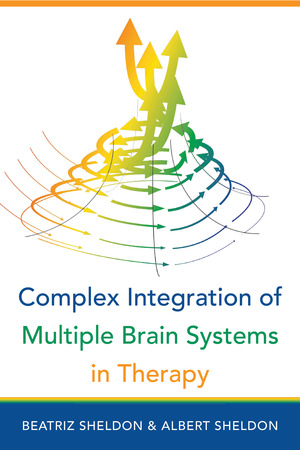 by Beatriz Sheldon and Albert Sheldon
by Beatriz Sheldon and Albert Sheldon
Beatriz Sheldon, MEd, and her partner, Albert Sheldon, MD, describe their novel therapeutic approach, Complex Integration of Multiple Brain Systems (CIMBS), in this new publication. Throughout the book, references are made to the Sheldons’s 20 years of working together, 15 years of clinical experience, and 10 years of training other practitioners in CIMBS therapy. The authors emphasize that they “are practical, empirical therapists” (p. xvii). The book is seeded with references to scientists who inspire the duo, especially Daniel J. Siegel, Joseph LeDoux, Antonio Domasio, and the late Jaak Panksepp. It must be noted that CIMBS therapy as laid out in this text contains no peer-reviewed qualitative or quantitative studies; instead, the authors utilize vignettes to discuss their methods.
The brain systems referred to in CIMBS are organized into sections much like those of the triune brain model, with an additional peripheral system in the heart, lungs, and intestines. What the triune brain model labels the lizard brain relates to the primary level, the mammal brain is the secondary level, and the human brain is the tertiary level. The Sheldons assign awareness, attention, authority, autonomy, and agency (the “A Team”) to the conscious tertiary level. The secondary level holds nonconscious, inhibitory systems of fear, grief, shame, and guilt. The primary level, also nonconscious, contains the systems of safe, care, connection, sensory, assertive, play, and seeking.
The patient accesses the hidden strengths of the nonconscious mind via the CIMBS therapist’s use of techniques like Transpiring Present Moment, Go the Other Way, and Initial Directed Activation. Transpiring Present Moment is reminiscent of Fritz Perls’s emphasis on the “here-and-now.” Go the Other Way asks the patient to avoid getting bogged down in traumatic memories and instead reach for personal strengths. The CIMBS therapist cultivates the therapeutic alliance using the Therapeutic Attachment Relationship, which includes physical postures that suggest safety, reminding us of Egan’s SOLER stance taught in many counseling programs. This intervention also recommends intense focus on the patient’s micro-expressions as a guide to their conscious and nonconscious processes. Ultimately, the patient will integrate all 20 brain systems effectively and reach Fail-Safe Complex Network, a new, durable neural structure generating improved mental health.
Although the authors refer several times to the text’s internal contradictions or incongruence, the writing has the same appeal as the work of the Sheldons’s mentor, Dan Siegel, who wrote the Foreword. The book asks readers to lean on their intuition, often reminding them to “trust the process.” Nicola Swaine has provided line drawings to clarify central concepts, much as Siegel uses a curled fist to describe the triune brain. The authors relate that this text was written expressly to provide an overview of the Sheldons’s 16-part CIMBS training series (recorded and live) for students and trainees, who will find the glossary and bibliography especially useful.
In the Foreword, Siegel refers to the “cross-disciplinary framework known as interpersonal neurobiology . . . [using] universal principles discovered by independent pursuits of knowledge” (p xii). It would be useful to know which principles are considered universal in this book. Psychology sits forever on the fence between hard and soft science; some declarations of fact are based on microscopic studies of physical structures, and some are useful models that are at least partly philosophical. This text contains both. Neurologists have observed neural repairs and rerouting; thus, neuroplasticity is a demonstrable fact. The Sheldons describe 20 brain systems while noting that “one could certainly make the case for more or fewer systems” (p. 26). Clearly the number and definition of these brain systems can be thought of as helpful metaphors, a bit like Marsha Linehan describes a “wise mind” that is not a physical structure existing in the brain.
Professional counselors who like eclectic methods and enjoy pulling inspiration from many sources will appreciate CIMBS and this flagship text. The authors caution practitioners not to use CIMBS for patients who struggle with borderline personality disorder or dissociative, bipolar, or psychotic disorders. Although the Sheldons encourage clinicians to practice with their highest-functioning patients, the wise professional counselor will first disclose methods and procedures to patients.
Sheldon, B., & Sheldon, A. (2021). Complex integration of multiple brain systems in therapy. W. W. Norton.
Reviewed by: Christine Sheppard, MA, LCPC, NCC
The Professional Counselor
http://tpcjournal.nbcc.org
